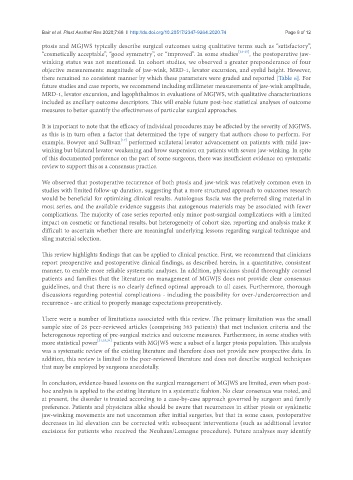Page 805 - Read Online
P. 805
Bair et al. Plast Aesthet Res 2020;7:68 I http://dx.doi.org/10.20517/2347-9264.2020.74 Page 9 of 12
ptosis and MGJWS typically describe surgical outcomes using qualitative terms such as “satisfactory”,
“cosmetically acceptable”, “good symmetry”, or “improved”. In some studies [22-25] , the postoperative jaw-
winking status was not mentioned. In cohort studies, we observed a greater preponderance of four
objective measurements: magnitude of jaw-wink, MRD-1, levator excursion, and eyelid height. However,
there remained no consistent manner by which these parameters were graded and reported [Table 6]. For
future studies and case reports, we recommend including millimeter measurements of jaw-wink amplitude,
MRD-1, levator excursion, and lagophthalmos in evaluations of MGJWS, with qualitative characterizations
included as ancillary outcome descriptors. This will enable future post-hoc statistical analyses of outcome
measures to better quantify the effectiveness of particular surgical approaches.
It is important to note that the efficacy of individual procedures may be affected by the severity of MGJWS,
as this is in turn often a factor that determined the type of surgery that authors chose to perform. For
[17]
example, Bowyer and Sullivan performed unilateral levator advancement on patients with mild jaw-
winking but bilateral levator weakening and brow suspension on patients with severe jaw-winking. In spite
of this documented preference on the part of some surgeons, there was insufficient evidence on systematic
review to support this as a consensus practice.
We observed that postoperative recurrence of both ptosis and jaw-wink was relatively common even in
studies with limited follow-up duration, suggesting that a more structured approach to outcomes research
would be beneficial for optimizing clinical results. Autologous fascia was the preferred sling material in
most series, and the available evidence suggests that autogenous materials may be associated with fewer
complications. The majority of case series reported only minor post-surgical complications with a limited
impact on cosmetic or functional results, but heterogeneity of cohort size, reporting and analysis make it
difficult to ascertain whether there are meaningful underlying lessons regarding surgical technique and
sling material selection.
This review highlights findings that can be applied to clinical practice. First, we recommend that clinicians
report preoperative and postoperative clinical findings, as described herein, in a quantitative, consistent
manner, to enable more reliable systematic analyses. In addition, physicians should thoroughly counsel
patients and families that the literature on management of MGWJS does not provide clear consensus
guidelines, and that there is no clearly defined optimal approach to all cases. Furthermore, thorough
discussions regarding potential complications - including the possibility for over-/undercorrection and
recurrence - are critical to properly manage expectations preoperatively.
There were a number of limitations associated with this review. The primary limitation was the small
sample size of 26 peer-reviewed articles (comprising 383 patients) that met inclusion criteria and the
heterogenous reporting of pre-surgical metrics and outcome measures. Furthermore, in some studies with
more statistical power [21,23,34] patients with MGJWS were a subset of a larger ptosis population. This analysis
was a systematic review of the existing literature and therefore does not provide new prospective data. In
addition, this review is limited to the peer-reviewed literature and does not describe surgical techniques
that may be employed by surgeons anecdotally.
In conclusion, evidence-based lessons on the surgical management of MGJWS are limited, even when post-
hoc analysis is applied to the existing literature in a systematic fashion. No clear consensus was noted, and
at present, the disorder is treated according to a case-by-case approach governed by surgeon and family
preference. Patients and physicians alike should be aware that recurrences in either ptosis or synkinetic
jaw-winking movements are not uncommon after initial surgeries, but that in some cases, postoperative
decreases in lid elevation can be corrected with subsequent interventions (such as additional levator
excisions for patients who received the Neuhaus/Lemagne procedure). Future analyses may identify

